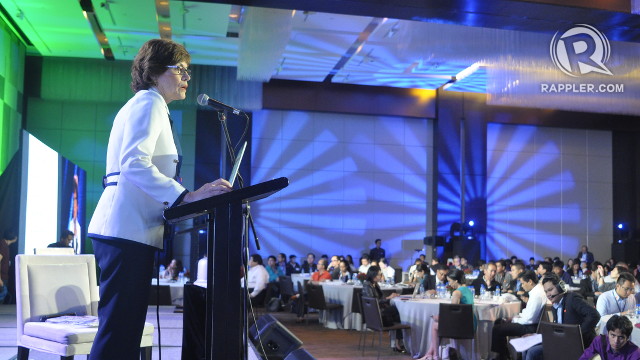SUMMARY
This is AI generated summarization, which may have errors. For context, always refer to the full article.
MANILA, Philippines – How can the Internet be used to tackle the most complex problems facing our world today?
Nancy Roberts, co-founder of analytics start-up CORE Lab at the US Naval Postgraduate School, is an expert on the immense power of the Internet to connect problems to solutions and empower users to drive change wherever they want from wherever they are.
At “#ThinkPH: Internet, Big Data and You,” a Rappler-Google-+SocialGood Summit held on Friday, August 23 at the New World Hotel in Makati, Roberts showed how Internet-enabled technologies are drawing the line between life and death during disasters, connecting citizens with government to solve community problems and even funding artists and entrepreneurs.
But this is only the tip of the iceberg. The world is only in the beginning phase of using the Internet to solve even bigger problems. Roberts said we might one day use the Internet to tackle what she called “wicked problems.”
Wicked problems
The term “wicked problem” was first coined by theorists Horst Rittel and Melvin Webber. Wicked problems are problems so complex that they defy all definitions and cannot be objectively answered. One person will define a wicked problem in a certain way while another will say the definition is actually the symptom of the problem.
“Every wicked problem is in a nest of other problems. It’s like peeling the layers of an onion,” said Roberts.
Problems as devious as these can be found in our latest headlines. They include climate change, corruption, environmental degradation, terrorism, resource scarcity and poverty.
The extreme flooding in Metro Manila during tropical storm “Maring” is a wicked problem.
Wicked problems are wicked because no set of potential solutions exit. There is no criteria to say when all solutions have been identified and considered. Wicked problems leave us crawling in a dark room where we don’t see the walls.
Even more alarming for would-be problem-solvers…
“There is no opportunity to learn by trial-and-error since every attempt counts significantly. You have no right to be wrong. You are gambling with people’s lives and resources. You simply do not know what the right solution is,” explained Roberts.
To put it simply, if there is no consensus about “the problem” and no consensus about the “solution,” you have landed in wicked problem territory.
The engaged approach
The traditional approach to solving wicked problems is a top-to-bottom method in which the government identifies the problem, asks an expert to identify solutions and funds programs of which citizens are merely passive beneficiaries.
But Roberts poses an alternative approach. Citizens themelves create self-organizing, problem-solving networks which pursue innovations to address the problem. Finding solutions is driven from the bottom-up.
This approach is not just a theory. It’s happening around us and it’s being driven by the Internet.
These citizen-initiated problem solving networks fall under 4 different types:
- Crowdsourcing
- Crowdfunding
- Crowd problem-finding
- Crowd solution generation
Case studies include the crowdsourcing initiative Ushahidi, an application that connected victims of a Haiti earthquake with the Red Cross by crowdsourcing information and mapping the help needed using big data. Haitians in need of food or medical assistance simply texted a crisis center and within moments, received the help they needed. Amazingly, the crisis center was in Boston and the Americans who received the messages in Creole would have them translated by thousands of online volunteers.
Crowdfunding website Kiva.org loans a minimum of US$25 to users who submit a project plan or business plan. Other users choose which projects they want to support and loan the amount needed to start it up.
Other websites like Indiegogo and KickStarter help artists embark on their masterpieces.
FixMyStreet.com, an example of crowd problem-finding technology, allows citizens to converse directly with city officials about problems in their neighborhood from racism to unsanitary potholes.
Crowd solution generation is alive in Challenge.gov where officials pose a challenge to citizens, empowering them to influence how the local government addresses problems.
All the examples Roberts showed do not necessarily tackle wicked problems. But the limitless possibilities of the Internet promise that one day, wicked problems will be nothing engaged and connected citizens can’t handle.
But Roberts emphasized that connectivity and the Internet can’t do it alone.
READ: Internet an ‘epic failure’
Netizens need to improve their competencies and skills to be better participants in the Internet. More than being connected, netizens must be coordinated. People from different disciplines must come together to create multi-faceted solutions to multi-faceted problems, she said. – Rappler.com
Add a comment
How does this make you feel?






There are no comments yet. Add your comment to start the conversation.